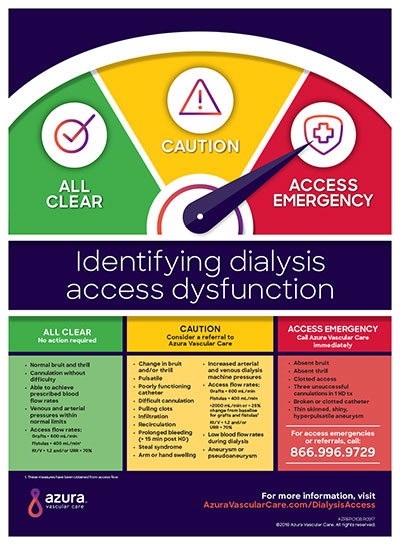
If you are one of the 468,000 i Americans on dialysis, you most likely understand how important it is to keep your dialysis access functioning properly. After all, it is your life line. As someone who undergoes dialysis regularly, you need to be diligent about checking your access daily, making sure it continues to work properly as this imperative to your health and well-being. But, are you aware of how easily you can check your dialysis access site on your own?
You can check your access site daily with the simple 3-step process:

Look

Listen

Feel
You need to look to be sure there are no signs of infection; listen for the swishing sound, or bruit; and feel your access to be sure that the thrill, or vibration, is still there and consistent.
If something has changed with your access, you should talk to your doctor or someone on your dialysis team.
9 Warning Signs That Could Indicate a Dysfunctional Dialysis Access
1. Inconsistent bruit – When you listen to your dialysis access, you should hear a consistent swishing sound called a bruit. If you don’t, it could be a sign that something is wrong. An inconsistent bruit is typically an early warning sign that you should let your dialysis team know about.
2. No bruit – Not hearing any sound when you place your ear or a stethoscope on your access site could mean that your access is blocked. This is something you should bring to the attention of your doctor or dialysis team right away.
3. Change in thrill – A change in thrill, or the vibration you feel when you place your hand over your access, is also an early sign that your access may be malfunctioning. Just like the bruit, when there’s a change in the thrill, it’s time to contact your dialysis team or doctor.
4. No thrill – Not being able to feel any thrill may indicate that your access has clotted. If you cannot feel a thrill when you place your hand over your access site, contact your doctor or dialysis team immediately.
5. Numbness, tingling or cold arm and hand – If your hand or arm on the side with the access starts to feel numb or cold or begins to tingle, poor circulation to your hand could be the problem. If you experience these symptoms, you should call your dialysis team or doctor to let them know.
6. Bleeding – Bleeding from your access site after your hemodialysis treatment is normal, but should only last for about 15-20 minutes. Bleeding for a longer period of time may be an early sign that you may have a stenosis (narrowing) in your fistula or graft. This is something you should bring to the attention of your dialysis team. Place a clean gauze pad over your access site and apply gentle pressure. If the bleeding doesn’t stop after about 15 minutes, you should call your doctor right away. If you have a catheter and notice bleeding, you need to go to an emergency room immediately.
7. Arm or hand swelling – A swollen arm or hand is something to take note of. If you have swelling without redness, drainage or warmth, chances are you do not have an infection. Swelling can also be caused by edema, or fluid retention, which is common in dialysis patients. However, if edema is the problem, your other hand and arm, and possibly your legs and feet, would also likely be swollen. Swelling in your arm and hand on your access side may signal that a more serious complication is brewing.
8. Broken catheter – If you notice that your central venous catheter (CVC) is broken or cracked you should report it to your dialysis team immediately. A broken catheter is an emergency and you should seek treatment right away.
9. Infection – Signs of infection include fever, swelling, redness and warmth near your access site, as well as drainage, or pus anywhere along your access arm, catheter or needle site. This should be reported to your physician immediately.
Dialysis is a lifesaving treatment and understanding how to take care of your dialysis access is imperative. Knowing what signs to look for to determine if something is going wrong is the first step in making sure that your access lasts and functions properly, keeping you healthy for years to come.
Sources:
iU.S. Renal Data System Annual Data Report (2015), Centers for Medicare & Medicaid Services
iiNational Kidney Foundation. (2017). A to Z Health Guide, Hemodialysis Access. https://www.kidney.org/sites/default/files/11-50-0216_va.pdf
iiiKornbau, C., Lee, K. C, Hughes, G. D., and Firstenberg, M.S. (2015). Central line complications. International Journal of Critical Illness and Injury Science, 5(3), 170–178



